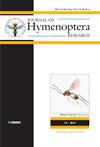Detection及北美西部四个小黄蜂(膜翅目,小黄蜂科)巢的描述
IF 1.4
3区 农林科学
Q2 ENTOMOLOGY
引用次数: 3
摘要
大黄蜂(Vespa mandarinia Smith 1852)是其他社会膜翅目昆虫的半专业化捕食者,是大黄蜂的两个最大种类之一。2019年,在加拿大和美国发现了几只这种掠食性黄蜂,其中包括在不列颠哥伦比亚省温哥华岛发现并摧毁的整个巢穴。自2020年以来,华盛顿州农业部和美国农业部动植物卫生检验局合作,利用由机构工作人员、地方政府和非政府组织的合作者以及公众组成的陷阱,对华盛顿州的鳜鱼进行了调查。诱捕器数据和公开报告用于选择现场诱捕或网调查的地点,随后收集在这些工作中捕获的活大黄蜂并安装无线电标签以定位巢穴。这项调查最终导致在2020年10月发现了一个V. mandarinia巢穴,在2021年8月和9月发现了三个巢穴。所有的巢都位于红桤木(Alnus rubra)内,其中一个巢在离地面刚刚高的一棵枯树中,另外三个巢在离地面2至5米的活树洞中。每个巢的蜂巢数量在4到10个之间,细胞数量在418到1329个之间,每个巢的黄蜂总数在449到1474个之间(包括未成熟和成熟阶段)。总之,这四个巢穴表明,在卡斯卡迪亚地区,橘斑蝶的种群处于初级阶段,地方、州、省和联邦政府以及两国居民都需要采取持续的行动,以避免在该地区建立这种外来物种。本文章由计算机程序翻译,如有差异,请以英文原文为准。
Detection and description of four Vespa mandarinia (Hymenoptera, Vespidae) nests in western North America
Vespa mandarinia Smith 1852 is a semi-specialized predator of other social Hymenoptera and one of the two largest species of Vespa. Several individuals of this predatory wasp were detected in Canada and the United States in 2019, including an entire nest that was located and destroyed on Vancouver Island, British Columbia. The Washington State Department of Agriculture and the United States Department of Agriculture’s Animal and Plant Health Inspection Service have collaborated to survey Washington State for V. mandarinia since 2020, using traps staffed by agency personnel, collaborators from local governments and nongovernmental organizations, and the general public. Trap data and public reports were used to select sites for live-trapping or net surveys, and live hornets captured in these efforts were subsequently collected and fitted with radio tags to locate nests. The survey ultimately led to the discovery of a V. mandarinia nest in October 2020, and three nests in August and September 2021. All of the nests were located within in red alder trees (Alnus rubra), with one just above the ground in a standing dead tree, and the other three in cavities ~2 to 5 meters above the ground in living trees. The number of combs in each nest varied between four and ten, cells between 418 and 1,329, and total hornets per nest between 449 and 1,474 (including immature and mature stages). Together, the four nests indicate an incipient population of V. mandarinia in the Cascadia region, and ongoing action by local, state, provincial, and federal governments, and residents of both countries is required to avoid the establishment of this exotic species in the region.
求助全文
通过发布文献求助,成功后即可免费获取论文全文。
去求助
来源期刊
CiteScore
2.60
自引率
15.40%
发文量
68
审稿时长
>12 weeks
期刊介绍:
The Journal of Hymenoptera Research is a peer-reviewed, open-access, rapid online journal launched to accelerate research on all aspects of Hymenoptera, including biology, behavior, ecology, systematics, taxonomy, genetics, and morphology.
All published papers can be freely copied, downloaded, printed and distributed at no charge for the reader. Authors are thus encouraged to post the pdf files of published papers on their homepages or elsewhere to expedite distribution. There is no charge for color.

 求助内容:
求助内容: 应助结果提醒方式:
应助结果提醒方式:


